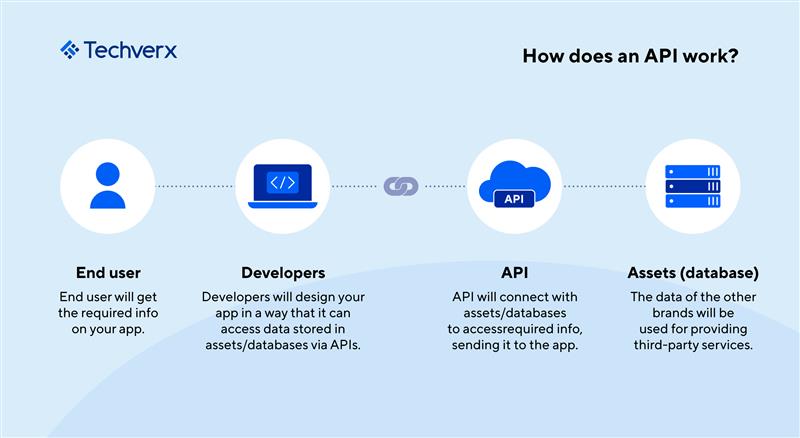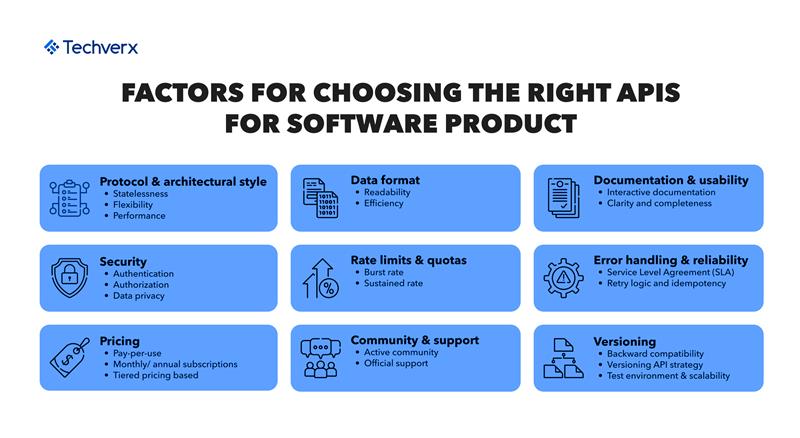
Top e-Commerce APIs to Power and Scale Your Online Store in 2025

APIs are the connective tissue of modern online retail. They let you add new capabilities without rebuilding your stack, from headless storefronts and personalized content to faster payments and streamlined operations. With the right API mix, you can boost conversions, cut friction, and move faster than competitors.

In brief:
- See the top 8 e-Commerce APIs that lift store functionality.
- Know how to choose APIs for compatibility, scalability, and security.
- Get a quick view of features in Shopify, Stripe, PayPal, and Amazon MWS.
- Follow integration best practices that reduce risk and improve CX.
A Techverx case study showing how the right technical approach + API choices unlocked performance gains, and how to apply those lessons to your stack.
Why e-Commerce APIs matter
APIs (Application Programming Interfaces) connect your store to payment gateways, CRMs, shipping partners, and marketing tools. When selected thoughtfully, they:
- Extend platform features without heavy custom builds
- Improve reliability and performance
- Enable consistent, personalized customer experiences
Below are the core API categories most stores rely on.
The Execution Gap: Where ERP Projects Stall
Strategy is cheap. Delivery isn’t.
Most ERP initiatives don’t fail on vision, they fail in execution.
Internal teams are stretched thin, balancing day-to-day operations with complex ERP requirements.
Good ERP talent is hard to hire, slow to onboard, and difficult to retain.
Misalignment between business goals and technical delivery creates rework, technical debt, and budget creep.
This is where projects go sideways, not because ERP lacks capability, but because execution lacked velocity, alignment, or expertise.
1) Payment APIs
Payment is the “make or break” moment. The right gateway should be easy to implement, global-ready, and secure.
Stripe API
- Flexible processing for one-time and recurring payments
- Subscription management baked in
- Tools for fraud detection and risk scoring
PayPal API
- Quick acceptance of PayPal, cards, and wallets
- Invoicing and recurring billing
- Broad developer support across REST and SOAP
2) Inventory APIs
Stock accuracy keeps pages honest and customers happy.
Amazon Marketplace Web Service (MWS)
- Deep inventory and order management features
- Automated reporting to inform merchandising decisions
- Hooks for syncing stock with Amazon sales
QuickBooks Commerce
- Centralized inventory tracking across channels
- Integrations with finance and back-office systems
3) Shipping APIs
Logistics are your post-click differentiator. Shipping APIs automate labels, rates, and tracking.
Shippo
- Multi-carrier support with competitive rates
- Address validation to reduce delivery errors
- Label creation and end-to-end tracking
4) Customer APIs
To personalize at scale, you need clean identity and flexible profiles.
- Social and federated login (Google, Facebook, etc.)
- Extendable customer records (custom attributes, tags)
- Foundation for targeted recommendations and offers
5) Product Information Management (PIM) APIs
PIM connects every touchpoint to a single source of product truth.
Akeneo, Pimcore, InRiver, Salsify
- Centralize titles, SKUs, categories, specifications
- Bulk import/update for fast catalog ops
- Push data to external marketplaces (Amazon, eBay)
- Manage images, videos, and documents
- Multi-language and regional variations
- Real-time synchronization across channels
6) Order Management APIs
From checkout to doorstep, orchestrate the flow with order APIs.
Shopify Order API, Salesforce Order Management API, Amazon MWS Orders
- Create/modify/cancel orders programmatically
- Real-time status tracking
- Integrations with inventory and shipping
- Automated routing to warehouses and suppliers
- Customer notifications for confirmations and updates
- Handling of partial shipments and backorders
7) CRM APIs
Bridge marketing, sales, and service with unified customer data.
Salesforce API, Pipedrive API
- Access profiles, preferences, and purchase history
- Audience segmentation and lifecycle automation
- Lead tracking and pipeline management
- Real-time sync with e-Commerce platforms
8) Marketing Automation APIs
Turn behavior into action, automatically.
Pardot, ActiveCampaign, Mailchimp Marketing
- Triggers for abandoned carts, post-purchase flows, offers
- Integrations with ad platforms and CDPs
- Campaign analytics and attribution
- Loyalty/rewards program support
- Dynamic content for 1:1 messaging
- A/B testing for subject lines, creatives, and offers
How to choose the right e-Commerce API
Compatibility. Start with your foundation (Shopify, WooCommerce, Magento, custom headless). Favor APIs with clear docs, SDKs, and robust support. If you’re headless or moving that way, ensure your APIs expose everything you’ll need via REST or GraphQL.
Scalability. Traffic spikes, bigger catalogs, and new regions will stress weak links. Look for proven throughput, rate-limit transparency, and sane pagination/webhooks so your pipeline scales cleanly.
Security. Payments and PII demand strong authentication, token management, and compliance (PCI DSS, GDPR, SOC 2 where relevant). Prefer providers with regular security updates and deprecation policies you can plan around.

Popular APIs and standout capabilities
Shopify API
- Manage products, customers, inventory, and orders in one place
- REST and GraphQL endpoints
- Build custom storefronts or apps, and pipe Shopify data into external systems
- Used at massive scale across a global merchant base
Stripe API
- Developer-friendly payments for cards, wallets, BNPL, and subscriptions
- Advanced fraud prevention and dispute tools
- SDKs for major languages to speed custom checkout builds
PayPal API
- Broad consumer trust and global reach
- REST + SOAP compatibility for legacy and modern stacks
- Payments, invoicing, and recurring billing in one toolkit
Amazon MWS API
- Automate selling operations on Amazon
- Programmatic access to inventory and order data
- XML/CSV for smooth system-to-system exchange
Best practices for integration
Assess needs first. Identify the exact jobs to be done (e.g., “reduce cart abandonment,” “accelerate catalog updates,” “cut label creation time”). Prototype in a sandbox, validate error handling, and confirm webhook/event behavior matches your architecture.
Instrument and monitor. Set SLIs/SLOs for latency and uptime. Log request IDs, rate-limit responses, and retries with backoff. Track version changes and deprecations so you can upgrade without fire drills.
Design for failure. Implement circuit breakers, graceful fallbacks (e.g., cached rates or stock), and idempotency for payment and order calls.
Case Study: Techverx × Aroma Retail | From Instability to Instant Pairing
Aroma Retail, a beauty and perfumery brand, offers Wi-Fi-enabled scent machines that let customers personalize fragrance experiences from anywhere. They were struggling with an unstable mobile app, frequent crashes, and slow device pairing (40–60 seconds), issues that frustrated customers and clogged support channels. Their delivery process also suffered from the absence of CI/CD and version control, which made debugging and deployments slow and risky.
What Techverx did:
- Codebase optimization and architecture redesign to stabilize the platform and set a foundation for scale.
- Implemented CI/CD and version control, enabling faster, structured deployments and cleaner debugging across environments.
- Optimized device connectivity, cutting pairing time from 40–60 seconds to near-instant—a direct boost to perceived performance and satisfaction.
- Strengthened QA and testing, which drove down crash frequency and improved reliability.
The impact:
- Pairing time reduced from 60 seconds to near-instant.
- Crashes dropped by 70%, resulting in a more stable customer experience.
- Introduction of CI/CD pipelines led to faster releases and smoother rollbacks.
- Support tickets decreased significantly, reflecting fewer user issues.
- The platform now supports new hardware integrations and future features, proving it’s ready for ongoing innovation.
API selection lessons you can apply:
- Prioritize stability enablers first. Before adding new customer-facing features, ensure your foundational APIs (auth, device/IoT connectivity, order/inventory, and deployment tooling) are reliable and observable. Aroma Retail’s largest wins came from stabilizing core flows and release processes.
- Choose APIs that match your architecture. If you’re headless or multi-channel, prefer APIs with modern auth, webhooks, and either GraphQL (for selective fetching) or well-structured REST so you can avoid over-fetching/under-fetching.
- Don’t ignore operability. APIs that come with strong SDKs, logging hooks, and rate-limit clarity will shorten incident resolution and reduce support ticket volume, exactly what happened once Techverx instituted CI/CD and testing discipline.
- Design for scale from day one. As you add devices, catalogs, or regions, ensure your payment, order, and inventory APIs handle throughput growth without timeouts or fragile retries.
Bottom line: Techverx turned an unreliable system into a high-performing, scalable platform by pairing smart architecture decisions with the right APIs and delivery practices, proof that integration quality matters as much as API choice
Putting it all together
e-Commerce APIs are not cosmetic add-ons; they are levers for growth. Payments, inventory, shipping, PIM, orders, CRM, and marketing each play a role in the customer journey, and your ability to scale. If you select APIs against compatibility, scalability, and security, and integrate them with sound engineering (monitoring, versioning, CI/CD, and failure handling), you’ll ship faster, fix issues sooner, and deliver the kind of experience customers remember.
Whether you’re modernizing a legacy stack or building a headless storefront from scratch, use the categories above as your shortlist, the Shopify/Stripe/PayPal/Amazon MWS capabilities as a benchmark, and the Aroma Retail story as a reminder that reliability and operability turn technology into results
Hiring engineers?
Reduce hiring costs by up to 70% and shorten your recruitment cycle from 40–50 days with Techverx’s team augmentation services.
Related blogs


